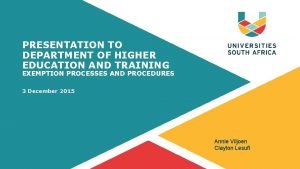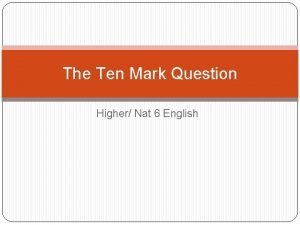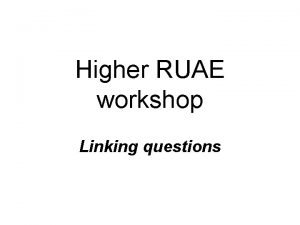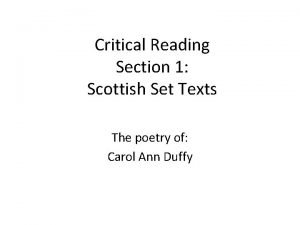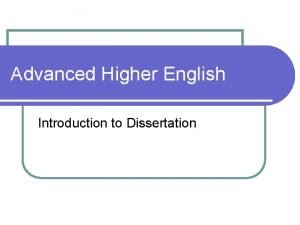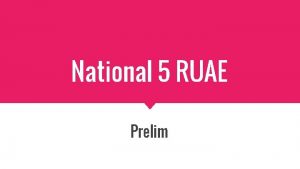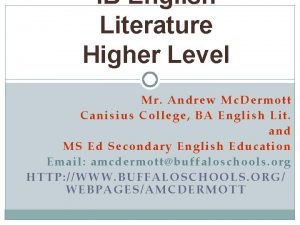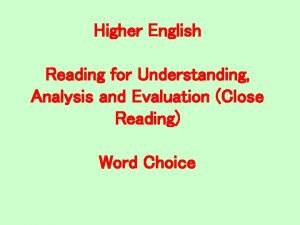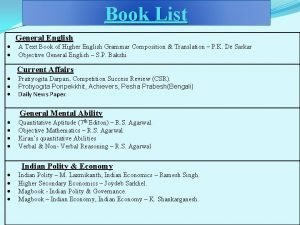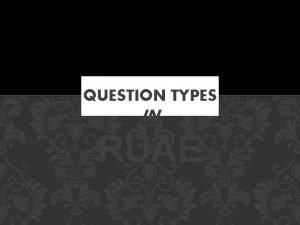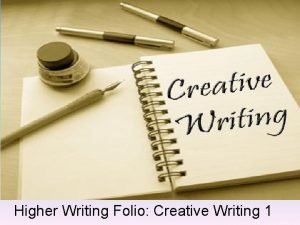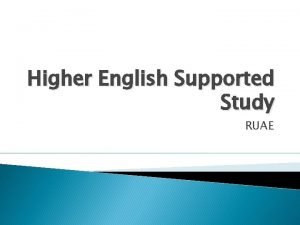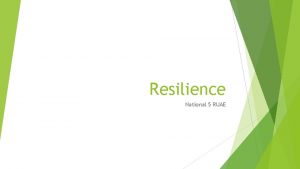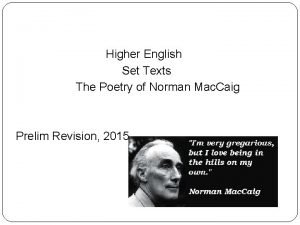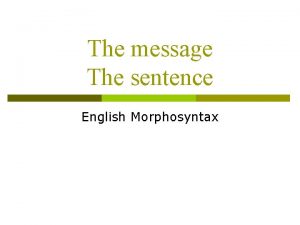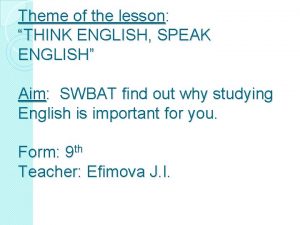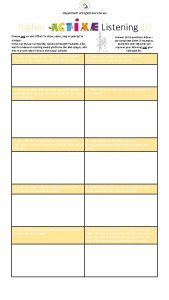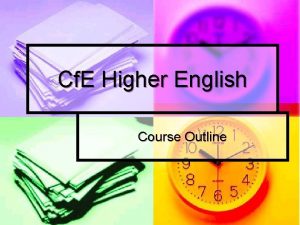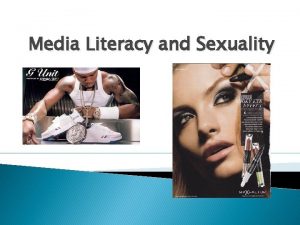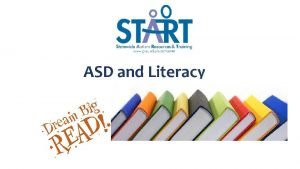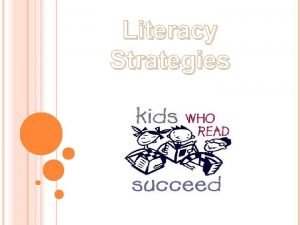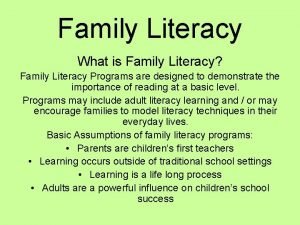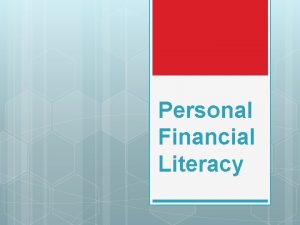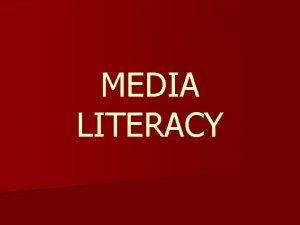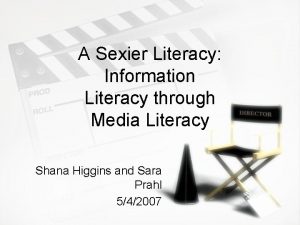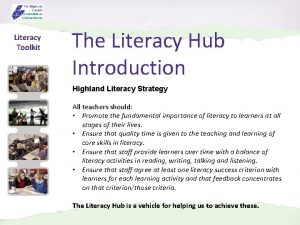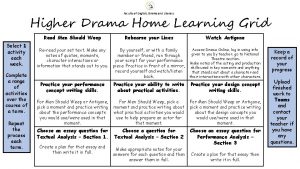Department of English and Literacy Higher and N

















































- Slides: 49

Department of English and Literacy Higher and N 5 Discursive Portfolio Persuasive Writing

The Learning • Remembering, understanding and applying the persuasive writing skills you already have • Understanding, analysing and evaluating examples of other people’s persuasive writing • Creating an original piece of persuasive writing Numeracy Literacy Working with Others Employability Cultural Literacy Critical Thinking Digital Literacy Health & Wellbeing Wider Achievement Political Literacy

Learning Activities 1. Choosing a thesis and planning your ideas 2. Writing a rough draft 3. Editing and revising your rough draft 4. Creating your final submission and reviewing your learning Significant Aspects of English and Literacy

1. Choosing a subject and planning your ideas Success Criteria üRead ‘What is Persuasive Writing? ’ üRead the ‘Choosing your Thesis’ slides, decide on your thesis and make a plan of your ideas üRead the ‘Carrying out Research’ slides üChoose your sources and take notes accordingly üCreate a detailed plan using the ‘Detailed Plan Instructions’ slides as a guide

What is Persuasive Writing? Persuasive writing is a type of writing that tries to convince a reader of a particular opinion or belief: usually the writer’s. You must try to get the audience on your side if you want to persuade them of something. This can be done by: • appealing to the audience's reason • appealing to audience's experiences • appealing to the audience's emotions

Choosing your Thesis: 1 What is a thesis? • The overall stance or position that your essay will argue • It is a statement, not a question • It is also the essay title How do you decide on a thesis? • Check out the examples given • Look online for your own ideas • Discuss possible topics with your friends/family • Make sure you decide on a stance in relation to the topic you’ve chosen • Ask your teacher to clarify any issues you have about a thesis • Ultimately, it has to be your choice: No topic> No thesis > No essay > No qualification

Choosing your Thesis: 2 Topic: General subject area Thesis: Specific stance in relation to topic 1. Gaming 1. Gaming truly is a healthy pastime 2. Pop music 2. All manufactured pop music should be banned 3. Graffiti should be viewed as art, not crime 4. Blood donation should be compulsory 5. Scottish independence should be avoided 6. Too much public money has been spent on sculptures and other forms of art in North Lanarkshire 7. Prisoners should have the right to vote 8. You. Tubers are role models 9. Music videos should be subjected to widespread censorship 3. Graffiti 4. Blood donation 5. Independence 6. Council spending 7. Prisoners’ rights 8. You. Tubers 9. Censorship 10. Ticket touts 10. Ticket touts are killing live music

Choosing your Thesis: 3 Check out these websites for possible topics: https: //www. thoughtco. com/pers uasive-essay-topics-1856978 https: //www. kibin. com/essaywriting-blog/20 -persuasive-essaytopics-help-get-started/ http: //www. myspeechclass. com/ persuasivetopics 2. html You can also check out #folioinspo and #Rf. UAE on social media for ideas

Choosing your Thesis: 4 • • • Planning Plan your ideas using a mind map or other visual organiser This kind of planning is meant to take a few minutes only Write down whatever comes in to your head Use colour, images and design if it helps It only needs to make sense to you If you find you can’t do it – you’ve probably picked the wrong topic

Carrying out Research: 1 Choosing Sources • One of the requirements of the task is that you should be able to find appropriate sources and use them in your essay either by referring to them or by quoting from them exactly • Make sure that you take a careful note of web pages, or pages from books you have used. You must save the exact web page. A really useful website is: https: //www. theguardian. com/uk but you cannot write this in to your sources • Instead you need to write the full URL: https: //www. theguardian. com/education/2018/feb/16/council-free-schoolmeals-year-holiday-hunger-north-lanarkshire • Although the SQA only require you to record 2 sources, it’s a good idea to find more

Carrying out Research: 2 Analysing and Evaluating Sources Once you have the sources, answer the following questions to ensure you understand them completely: 1. Understand Purpose: What is the point of the source (Inform/Explain/Persuade/Entertain) and how do you know? 2. Understand Audience: Who is the source aimed at and how do you know? 3. Understand Main Ideas: Summarise in bullet points the main points the source makes 4. Analyse: What language techniques does the source use to communicate with the reader/listener? 5. Evaluate: How successful was the source at achieving its purpose? 6. Compare: What similarities and/or differences were there between sources you picked? Which one did you prefer and why?

Carrying out Research: 3 Taking notes from a Source • Avoid copying large sections of information from sources. Instead note down the main ideas in the text. • Translate the information you have found into your own words as far as possible. • Include evidence as well as statements to help prove your point and make your point stronger. Plagiarism It is vitally important that you always use your own words and do not copy chunks from the passage. When you include a quotation from someone, you must acknowledge it and include a footnote about where you found it (website or newspaper etc. ) If you are found to have plagiarised any of your essay, there are very serious consequences.

Detailed Plan Instructions: 1 It’s a really important part of your portfolio work to have a detailed plan to hand in along with your essay. Use the following as a template: 1. Introduction: Choice of: rhetorical question/quotation/definition/fact/illustration/provocative statement/anecdote Then: clear statement of intent (your thesis) 100 - 150 words depending on level 2. First argument with supporting evidence: • Starts with a clear topic sentence • Clearly states the argument • Contains at least two pieces of evidence to support the argument • Contains appropriate transitions between pieces of evidence • Contains a transition statement to the next argument • Contains at least two persuasive techniques 150 – 200 words depending on level 3. Second argument as above 150 – 200 words depending on level 4. Third argument as above 150 – 200 words depending on level 5. Fourth argument as above 150 – 200 words depending on level

Detailed Plan Instructions: 2 6. Opposing argument(s) with refutation: • Starts with a clear topic sentence • Clearly states an opposing viewpoint(s) • Contains at least two reasons to disapprove opposing viewpoint • Contains a transition statement to the conclusion • Contains at least two persuasive techniques 150 – 200 words depending on level 7. Conclusion: restate opening position/summarise main points and then a choice of: a prediction/a question that will let the reader make their own prediction/a recommendation/a quotation 100 – 150 words depending on level

2. Writing your rough draft Success Criteria ü Get something down on the page as quickly as you can - at this stage, it doesn’t have to be perfect ü Concentrate on letting your work flow – try not to stop and start too many times ü You should attempt to write approximately 1000 words (N 5) 1300 (H) ü Keep the Discursive Writing and Tools for Writing success criteria in mind ü Use PERSUADER techniques so that they enhance your argument ü Check out the vocabulary bank and the various models if you need some help to get started

Discursive Writing Success Criteria ü Piece is within word limit ü Satisfactory technical accuracy has been achieved ü Attention to purpose and audience is reasonably well sustained ü Reasonable understanding of the topic or issue ü Evidence of some research and sources acknowledged ü Line of thought or stance is evident ü Linguistic features of the chosen genre used with a degree of success ü Language is effective in the main ü Structure is appropriate to purpose/meaning

Tools for Writing Success Criteria üSpell most of the words used correctly üUse punctuation that is varied and mostly accurate üUse sentences of different types and lengths üUse paragraphs correctly to structure writing üPresent work in a clear and legible way

The Persuader The PESUADER is an acronym that will hopefully help you to remember all of the different persuasive techniques that are at your fingertips.

The Persuader: Personal Pronouns When you use personal pronouns such as we, us, you are trying to involve the reader directly. ‘Of course we all know that taking drugs is morally wrong’ ‘You and I know that taking drugs is such a waste of time and a waste of a life’

The Persuader: Emotive Language Emotive words arouse strong feelings in the reader and encourage them to read on. ‘The number of young people who take drugs is absolutely shocking’ ‘It is reaching alarming proportions’ ‘Ministers have vowed to rid the country of the illicit drug trade’ ‘Drugs are a menace to society’

The Persuader: Rhetorical Questions These are questions which are ‘How will the youth of today learn directed at the readers, but do not and grow if you are continuously require answers. mollycoddling them and treating them like rare china? ’ Again, the readers feel as if they are being spoken to directly.

The Persuader: Statistics and Facts Numerical facts and statements that are true and can be proved: opposite of opinion ‘In 2008/2009, the Royal family cost Britain £ 40 million’ ‘A survey completed in Brixton Prison showed that almost three quarters of those incarcerated had mental health problems’

The Persuader: Use of an Authority Figure Important people or experts can make your argument seem more convincing. ‘When Michael Howard was Conservative Home Secretary, he famously remarked ‘Prison Works’

The Persuader: Alliteration and Anecdotes Alliteration is the repetition of the ‘But soon the big, bright balloon of celebrity culture will burst’ same sound or letter at the beginning of each or most of the words in a sentence. Anecdotes are a short account of a particular incident or event, especially of an interesting or amusing nature.

The Persuader: Description and Imagery The use of similes and metaphors ‘Drugs are deadly weapons’ to again help illustrate a point and describe anecdotes. ‘Taking drugs is like flushing your life down the toilet’

The Persuader: Exaggeration is when you are making something seem larger or greater than it really is in order to make a point ‘While we await your decision, the whole school holds its breath’

The Persuader: Repetition ‘Evil minds will use evil means’ Repeat key words or phrases to help key themes and arguments stick in the mind of your audience. ‘The best for furniture; the best for service; the best for your money’ Makes it memorable. Repeating something three times, sometimes called The Rule of Three or triples is a common technique in persuasive writing.

Techniques for an Effective Introduction Quotation: Henry Ford once claimed, “Capital punishment is as fundamentally wrong as a cure for crime as charity is wrong as a cure for poverty. ” Definition: Euthanasia is the act of killing someone to relieve pain and suffering. Fact: On February 12, 1994, Sue Rodrigues defied Canadian law and, with the help of an unidentified physician, ended her life. Illustration: Public executions take place infrequently in Iran and only when the crime is deemed to have caused particular public outrage. When a man, found guilty of murdering twenty-one young children was put to death in the town of Pakdash, south of Tehran, correspondents were invited to watch justice being administered. Provocative Statement: It is difficult to see how any intelligent person can approve of the capital punishment. Anecdote: I have always detested fox hunting since I was almost physically sick while watching a television film of the kill at the end of a hunt.

Vocabulary Bank 1: Signposts Comparisons • • • additionally similarly likewise/like in the same way furthermoreover also in addition too/even as/and Contrasts • although • for all that • however • on the contrary • having said that • otherwise • on the other hand • anyway • nevertheless • but • in contrast • alternatively • even so • whereas • while • though

Vocabulary Bank 2: Signposts Continued Consequences Confirmations • to this end • for example • for this reason • in other words • for this purpose • by way of illustration • accordingly • that is to say (: ) • as a consequence • as exemplified by • as a result • for instance • therefore Conclusions • inevitably • as has been noted • consequently • finally • with the result • in brief • unless • on the whole • because • in other words • since • whether • in conclusion

Model Introduction More energy, more stamina and a great taste! In reality: no teeth, no sleep and a thirst for caffeine. The retail chain Spar has given the go-ahead to traffic the new Scottish energy drink ‘Nae Danger’. The originator of this cocktail of chemicals breaks into a viciously competitive market dictated by the likes of Rockstar and Redbull. According to a report by Britvic, the UK energy drink market grew by 17% last year and is now worth more than £ 790 million. With money to be made, it is no surprise that the consumption, the acceptance, the normalisation and the concern of these beverages has dramatically risen. It has somehow become the norm to see pupils, students and workers alike carrying these cans, obviously naïve to not only the negative impact it has our general health and well-being, but naïve to the negative impact on their reputation and our reputation as a whole. Yes, the working man’s ‘rocket fuel’, can have an unfavourable impingement on a person’s health and well-being. Monster, Rage, Rockstar, Boost, Burn (I could go on) are just some of the names of these much-loved trendy, but damaging energy drinks – clearly aimed at adolescents – consumed in Scotland. For me, the titles of these toxic drinks already paint a very vivid picture but for those still unaware, I will go on to tackle, not only the serious health risks but the stereotypical image that tags along with the consumers. That image is hurting Scotland’s reputation as a whole.

Model Main Body 1 A large number of energy drink abusers would squabble that they lack the energy and stamina to do the things they need to do such as studying for exams, creating a presentation or the needing to get through the working day. This may be somewhat true as the demands and pressures of work and personal life seem even greater now in the year 2020. However, there are many healthier alternative sources of energy, such as fruit, that will not only be effective but you will certainly feel healthier, therefore good about yourself afterwards. Fruit contains natural sugars and acids unlike energy drinks. Take an apple, for instance: studies have shown that an apple’s energizing natural acids and sugars are more effective at waking up a person in the morning than a cup of tea. Other naive abusers would retaliate by mindlessly stating that time is an issue, that having a quick can of Monster is much easier. But in all seriousness, ask yourself this: is eating an apple that time consuming? When we eat an apple, we know exactly what we are eating. On the other hand, when you drink a can of Nae Danger, do you have any idea what you are slurping down your throat?

Model Main Body 2 I don’t even feel comfortable describing what slime lies within these cans but I will in the hope that you’ll drop them in horror, in shock, in realisation; maybe making you seriously consider ever picking them up again. Monster is packed with teeth rotting additives and other chemicals. Ironic, due to the fact you’d most likely resemble a monster bearing in mind your teeth are eroded having consumed this sludge. And the scary part has still to come…

Model Main Body 3 Although some brands claim their product is ‘sugar-free’ or “Nae sugar”, I guarantee this certainly doesn’t make their beloved beverages harmless in any way, shape or form. There are mountains more to worry about than the sugar content of these drinks. Any decent dentist will tell you how the enamel on our teeth plays an important part at keeping our teeth strong and healthy. According to a report on oral health by Spectrum Dental and Prosthodontics, excessive consumption of energy drinks will wear away your enamel leaving you prone to sensitivities and causing tooth decay due to carbonation and highly acidic ingredients. You can brush your teeth all you want, but being a regular consumer of such acids can’t possibly have a positive influence on your general health and well-being and will soon catch up on you. This damage is irreversible. So the only question is: why have we accepted such damaging drinks in our society that sit acting all innocent on our supermarket shelves and our own cupboards? This is one of countless long term effects.

Model Main Body 4 It would now make sense to make an educated assumption of your realisation that the negative effects of energy drinks already out-weigh the positive. Numerous nutritionists have revealed how frequent ingestion of caffeinated drinks, heavily weighed down by sugars, are a possible ground zero for a diabetic lifetime. Also insomnia, headaches, nervousness, palpitations, tremors, agitation, gastrointestinal upset, chest pains, dizziness, paraesthesia (tingling or numbing of the skin) and respiratory distress are side effects to watch out for whilst under the influence of these beverages. A number of these side effects are due to the high dosage of caffeine.

Model Main Body 5 Approximately 90% of adults in the US consume caffeine on a daily basis, therefore caffeine is considered one of the most commonly used psychoactive drug in the world. Evidence shows it’s addictive, and just like any other addictive drug, there comes joyless withdrawal symptoms. Plenty of people would try to inform you that caffeine addiction isn’t serious. Yes, in comparison to drugs such as heroin it’s nowhere near as addictive, but that is stating the obvious. Caffeine on its own is still a severe problem and a more common one to be exact. Withdrawal symptoms include: headaches, anxiety, fatigue, irritability, nausea, muscle pain, a depressed mood, lack of alertness and, a difficulty concentrating – these symptoms can occur less than 24 hours after quitting. An average cup of coffee has up to 150 mg of caffeine in it, while some brands of energy drink have as much as 500 mg.

Model Main Body 6 The days that you could argue that energy drinks were primarily consumed by our uttermost sport enthusiasts and truck drivers are long gone. Nowadays, a much greater number of the community feel comfortable purchasing energy drinks. The advertisements of aforementioned drinks now capture the attention of those palefaced robot-like gamers or dull-skinned sleep deprived computer slaves devoted to staying up all night, every night. In fact, it wouldn’t be out of character if these types of people buy their energy drinks online to avoid leaving their computers and interacting with non-virtual people. Now, surely the last thing we want is to be flagged up as a nation that encourages this behaviour or worse, to come under this stereotypical image ourselves. In short, if you care about your body and care about you reputation, it’s probably not a good idea to obliviously sit in class with a can of Monster tucked under your seat.

Model Conclusion With Scotland’s reputation and the people of Scotland in mind, it is essential that we take action of some description towards these brands. For the sake of our welfare, it is crucial that we either demand these energy drink companies change their formula to something less detrimental, or that we simply banish these beverages altogether. The government could introduce a caffeine limit or even impose a rule that enforces distributers to make consumers aware of what they are putting into their bodies; listing all of the ingredients on each and every can sold on shop shelves. We at least have the right to know what we are putting into our own bodies – there’s certainly, Nae Danger in that.

Model Word Count and Sources Word Count: 1231 Sources: http: //www. hype. com/vibe/energy-drink-benefits/ http: //www. caffeineinformer. com/energy-drink-ingredients http: //www. caffeineinformer. com/energy-drink-side-effects http: //www. theguardian. com/commentisfree/2012/dec/07/energy-drinks-health-readersrespond http: //lifehacker. com/5585217/what-caffeine-actually-does-to-your-brain http: //www. divinecaroline. com/life-etc/home-food/what-your-energy-drink-says-aboutyou http: //www. scotsman. com/business/food-drink-agriculture/spar-agrees-to-stock-scotsenergy-drink-nae-danger-1 -2704841 http: //www. livestrong. com/article/308744 -what-are-the-benefits-of-monster-energy-

3. Editing and revising your rough draft Success Criteria ü Read the ‘Why Edit and Revise’ slide ü Read back over your finished piece – how does it sound out loud? ü Can you read it to anyone else and let them give you some feedback? ü Read it backwards, one sentence at a time – that way you will spot many more things you want to change ü Follow each of the steps on the ‘Checklist’ slides – use different colours of pen or highlighters if you have them to make each stage of correction clear ü Contact the teacher for advice if there’s anything you are not sure about

Why Edit and Revise? When you are ready to share your writing with others, it is important to take time to re-read what you have written to make sure that your message is clear and that your spelling, punctuation and grammar are polished. The word revision means to ‘look again’. After writing a rough draft, successful writers ‘look again’ at their writing to make sure that they have accomplished what they set out to do.

Stage 1 Checklist: Purpose, Audience and Form Purpose Is your piece designed to Inform? Persuade? Explain? Entertain? Maybe it’s a mix of them all? ü Make sure you know the purpose of what you are writing and that is clear for the reader too. Audience Who is your piece aimed at – who is your readership? Is it a specific age group? Maybe it’s people who have a particular job or interest? ü Make sure that everything you have written is geared towards engaging the group you are aiming at. Form What type of writing should your piece be? What layout and presentation should you have? For instance: if it’s a report, do you know how to set that out properly? ü Make sure you have chosen the correct format for your writing.

Stage 2 Checklist: Vocabulary Creative Writing Have you used similes, metaphors, personification and other types of imagery? What about a variety of adjectives, verbs and adverbs? Discursive Writing Have you used straightforward and formal language for a report? Have you used subject specific words? What about persuasive vocabulary for a speech or an essay? üMake sure you have thought carefully about all of the words you have used as they will help the reader to understand relate to your piece.

Stage 3 Checklist: Tools for Writing Spelling Have you checked the spelling of the words you often get wrong? Have you checked the spelling of new words? üCorrect any spelling errors that you can see. Punctuation Have you used the correct punctuation? Does your piece contain a good range of punctuation? Have you left any punctuation out? üCorrect any punctuation errors that you can see. Grammar Does it make sense? Can you track back through the sentences that don’t make sense to see where you’ve gone wrong? üFind and change all of the errors you can.

Stage 4 Checklist: Organisation Presentation Does it look nice on the page? Is it spaced out well? Have you used a certain design or theme all of the way through? Have you used bullet points and/or graphics? üMake sure the way you have presented your work is in line with the way that is expected. Sections/Paragraphs Is it organised into clear paragraphs? Are there topic sentences and signposts to help guide the reader through your piece? Does it contain headings and subheadings if your piece requires them? üMake sure your finished piece is organised in a way that helps readers understand it.

Stage 5 Checklist: Editing Remove Do you have words or sentences that don’t seem to fit in? Have you changed your mind about a reference you’ve used? Have you got any words or sentences that were not bringing anything to your piece? üTake away 1 – 3 sentences from anywhere in the piece that you think were not as strong as you would have liked. Add Have you missed out any words? Maybe you’ve forgotten to add an important point or piece of description? üTry adding between 1 – 3 sentences that you think will make more of an impact in your writing.

Model Edit Before the process I don’t even feel comfortable describing what lies within these cans but i will in the hope that you’ll drop them in horror. Monster is packed with additives and other chemicals. Why would people even want to put them in their bodies, I do not know? Purpose: to persuade reader about the dangers of energy drinks √ During the process Audience: Form: essay √ teacher family, peers √ I don’t even feel comfortable describing what slime lies within these cans but I will in the hope that you’ll drop them in horror, in shock, in Vocabulary: some changes realisation; maybe making you seriously consider ever picking them up again. Monster is packed with teeth rotting additives and other chemicals. Why would people even want to put them in their bodies, I do not know? Ironic, due to the fact you’d most likely resemble a monster bearing in mind your teeth are eroded having consumed this sludge. And the scary part has still to come… Presentation: √ Paragraphs: √ Tools for writing: Editing: (Add/Take some corrections Away) some changes

4 a. Creating your final submission Success Criteria ü If working digitally: type with a plain black font, 12 point ü If handwriting: use lined A 4 paper and a blue or black pen ü Include all of the corrections/changes you have made ü Make a front cover with your name, class, thesis, word count and source URLs ü Include a copy of your detailed plan ü Send your final submission in by Wednesday 24 th June ü If photographing a handwritten piece, ensure it is a clear picture and all of the text can be read easily

4 b. Reviewing the Learning Success Criteria üAre you pleased with your persuasive essay – what do you particularly like about it? üIs there anything you found challenging about the task? üIf you did the task again, would you do anything differently?
 Similarities of media literacy and information literacy
Similarities of media literacy and information literacy Venn diagram media information and technology literacy
Venn diagram media information and technology literacy Two types of people media
Two types of people media Cyber literacy and digital literacy
Cyber literacy and digital literacy School education and literacy department
School education and literacy department Education and literacy department sindh
Education and literacy department sindh Department of higher education and training
Department of higher education and training Ohio department of higher education
Ohio department of higher education English literacy in europe
English literacy in europe Understanding standards advanced higher english
Understanding standards advanced higher english Higher english 10 mark question
Higher english 10 mark question The red door critical essay example
The red door critical essay example Linking sentence examples
Linking sentence examples Sentence structure higher english
Sentence structure higher english How to answer effective conclusion questions
How to answer effective conclusion questions English imagery
English imagery The way my mother speaks carol ann duffy
The way my mother speaks carol ann duffy Advanced higher english dissertation examples
Advanced higher english dissertation examples Advanced higher health and food technology
Advanced higher health and food technology Ruae question types higher
Ruae question types higher Ib english higher level
Ib english higher level Higher english close reading
Higher english close reading A text book of higher english grammar
A text book of higher english grammar Advanced higher english literary study
Advanced higher english literary study Sqa art and design understanding standards
Sqa art and design understanding standards Higher modern studies understanding standards
Higher modern studies understanding standards Higher english ruae question types
Higher english ruae question types Higher english folio
Higher english folio How to answer ruae questions higher english
How to answer ruae questions higher english Higher english close reading
Higher english close reading Understanding standards advanced higher english
Understanding standards advanced higher english National 5 ruae
National 5 ruae Humorous tone
Humorous tone Aunt julia higher english
Aunt julia higher english Aunt julia set text questions higher
Aunt julia set text questions higher Ruae higher english
Ruae higher english Imagery higher english
Imagery higher english Ruae higher english
Ruae higher english Selling manhattan carol ann duffy analysis
Selling manhattan carol ann duffy analysis Advanced higher history dissertation examples
Advanced higher history dissertation examples Iup orientation
Iup orientation Strategic planning institute
Strategic planning institute Royal holloway english department
Royal holloway english department Ndsu disability services
Ndsu disability services Spoken english and broken english
Spoken english and broken english Differences between americans and british
Differences between americans and british British english vs american english
British english vs american english Spoken english and broken english summary
Spoken english and broken english summary Rhodic english
Rhodic english Think in english speak in english
Think in english speak in english






